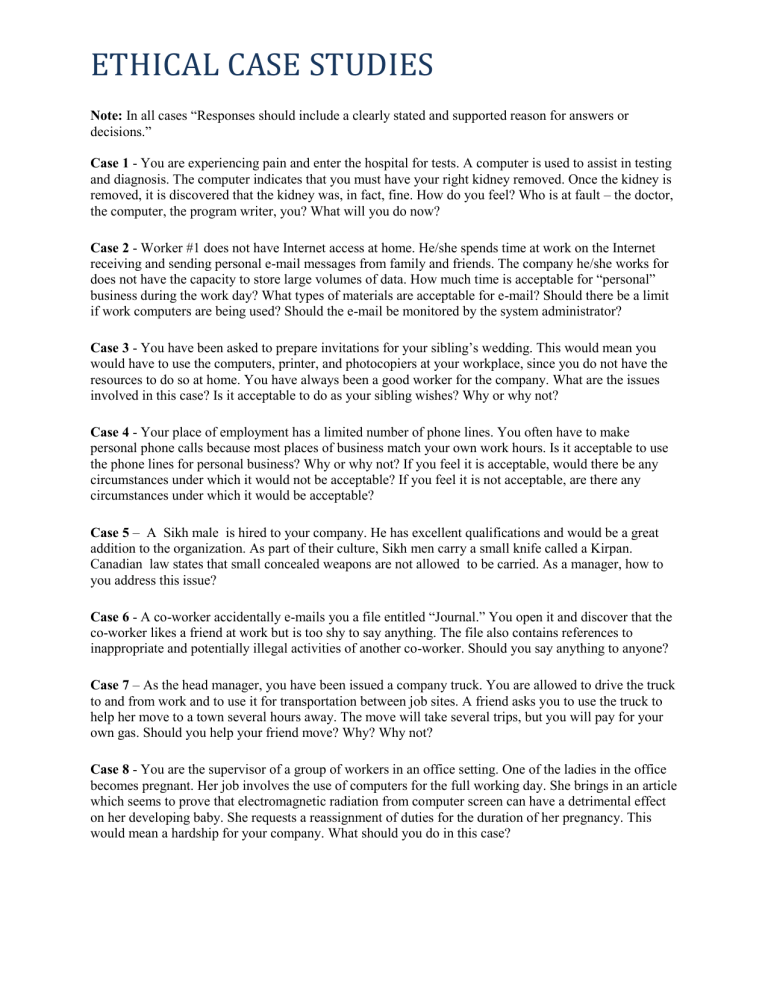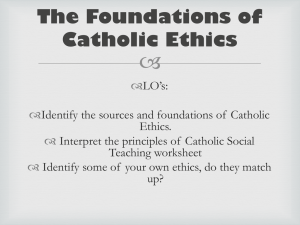
ETHICAL CASE STUDIES Note: In all cases “Responses should include a clearly stated and supported reason for answers or decisions.” Case 1 - You are experiencing pain and enter the hospital for tests. A computer is used to assist in testing and diagnosis. The computer indicates that you must have your right kidney removed. Once the kidney is removed, it is discovered that the kidney was, in fact, fine. How do you feel? Who is at fault – the doctor, the computer, the program writer, you? What will you do now? Case 2 - Worker #1 does not have Internet access at home. He/she spends time at work on the Internet receiving and sending personal e-mail messages from family and friends. The company he/she works for does not have the capacity to store large volumes of data. How much time is acceptable for “personal” business during the work day? What types of materials are acceptable for e-mail? Should there be a limit if work computers are being used? Should the e-mail be monitored by the system administrator? Case 3 - You have been asked to prepare invitations for your sibling’s wedding. This would mean you would have to use the computers, printer, and photocopiers at your workplace, since you do not have the resources to do so at home. You have always been a good worker for the company. What are the issues involved in this case? Is it acceptable to do as your sibling wishes? Why or why not? Case 4 - Your place of employment has a limited number of phone lines. You often have to make personal phone calls because most places of business match your own work hours. Is it acceptable to use the phone lines for personal business? Why or why not? If you feel it is acceptable, would there be any circumstances under which it would not be acceptable? If you feel it is not acceptable, are there any circumstances under which it would be acceptable? Case 5 – A Sikh male is hired to your company. He has excellent qualifications and would be a great addition to the organization. As part of their culture, Sikh men carry a small knife called a Kirpan. Canadian law states that small concealed weapons are not allowed to be carried. As a manager, how to you address this issue? Case 6 - A co-worker accidentally e-mails you a file entitled “Journal.” You open it and discover that the co-worker likes a friend at work but is too shy to say anything. The file also contains references to inappropriate and potentially illegal activities of another co-worker. Should you say anything to anyone? Case 7 – As the head manager, you have been issued a company truck. You are allowed to drive the truck to and from work and to use it for transportation between job sites. A friend asks you to use the truck to help her move to a town several hours away. The move will take several trips, but you will pay for your own gas. Should you help your friend move? Why? Why not? Case 8 - You are the supervisor of a group of workers in an office setting. One of the ladies in the office becomes pregnant. Her job involves the use of computers for the full working day. She brings in an article which seems to prove that electromagnetic radiation from computer screen can have a detrimental effect on her developing baby. She requests a reassignment of duties for the duration of her pregnancy. This would mean a hardship for your company. What should you do in this case? ETHICS CASE STUDY PRESENTATION RUBRIC Category/Criteria Knowledge/ Understanding Social, legal, political, cultural, and environmental implications of IT use Communication Presentation of research and reflection Thinking/Inquiry Content Reflection content Demonstrating specific idea development Application Use of transitions, graphics, charts, bulleted text, and appropriate choice of fonts Level 1 Level 2 (50-59%) (60-69%) - limited ability - some ability to to identify ethical identify ethical implications implications Level 3 (70-79%) - considerable ability to identify ethical implications Level 4 (80-100%) - strong ability to identify ethical implications - information communicated with limited clarity - information communicated with moderate clarity - limited connections made to Catholic teachings and extension of ideas beyond case - limited and superficial demonstration of idea development - limited use of features taught - some connections made to Catholic teachings and extension of ideas beyond case - some breadth and depth of thought - information communicated with considerable clarity - considerable connections made to Catholic teachings and extension of ideas beyond case - good depth and breadth of thought - information communicated with high degree of clarity and confidence - strong connections made to Catholic teachings and extension of ideas beyond case - insightful and thorough breadth and depth of thought - some use of features taught - effective use of features taught - exemplary and creative use of features taught Note: A student whose achievement is below level 1 (50%) has not met the expectations for this assignment or activity. Activity 2.3 – Ethical Case Studies The teacher: introduces the LISTEN Method of decision-making to students. Look for the facts (figure out what the real situation is – what, who, when, where, why, how) Imagine possibilities (consequences, creative options) Seek insight beyond your own (family, wise persons, religion, moral principles) Turn inward (feelings, insights from experience, motives, values “gut feelings”) Expect God’s help (God is present in your life and in your honest attempts to seek the truth) Name your decision (perhaps you must put it off for a time, don’t just drift, if you don’t decide, someone else will decide for you); divides the class into groups of two or three and assigns a case to each group (see Appendix 2.2.6). Students: prepare an electronic slide presentation of their findings. Students use the following features: transitions, graphics, chart, bulleted text and appropriate choice of fonts; present the case (or ethical problem) for study, using the LISTEN Model to complete a chart showing their findings in the case, and give the rationale for their decision explaining what core ethical principles and Christian values weighed in their decision; present their findings to the class. A short, timed discussion of each case occurs, if time allows. Assessment & Evaluation of Student Achievement The teacher and students gather assessment information based on the specific expectations, including: formative assessment of student participation in class discussions based on observation; formative assessment of the chart and paragraph on school computer and Internet user policy (Appendix 2.2.4); summative evaluation of word-processed document with columns and graphics (Appendix 2.2.5); summative evaluation of the slide presentation with findings (Appendix 2.2.7); summative evaluation of personal and Christian development in slide presentation. Accommodations The following are ways in which the activities can meet student’s individual needs: provide individual or small group support to students who are lacking the required background skills; grouping of strong students with peers who require extra assistance; provide computer access outside of class time; encourage students who require enrichment to visit more challenging websites; provide a glossary of ethics terminology with definitions. Resources Ethics/Ethical Decision Making http://library/thinkquest.org/ http://www.goodcharacter.com (free character education resources for teachers) http://josephsoninstitute.org/MED/medtoc.htm (The Six Pillars of Character) Ahlers, Julia, Barbara Allaire, and Carl Koch. Teaching Manual for Growing in Christian Morality. Winona, Minnesota: Saint Mary’s Press, 1996. ISBN 0-88489-388-X (LISTEN Method) Catholic Teaching http://www.faynet.com/csmfay/principl.htm (Major principles of Catholic Social Teaching) http://www.osjspm.org/cst6prin.htm (Principles of Catholic Social Teaching) http://www.uscatholic.org/cstline/tline.html (Busy Christian’s Guide to Catholic Social Teaching) http://www.csnmail.net/~dsao/cst1.htm (Overview of Catholic Social Teaching) http://www.osjspm.org/cst/csted.htm (Resources for Catholic Educators) http://www.csbsju.edu/library/research/theomorl.html (Moral Theology Resources) LISTEN METHOD OF DECISION-MAKING Look for the facts (figure out what the real situation is – what, who, when, where, why, how) Imagine possibilities (consequences, creative options) Seek insight beyond your own (family, wise persons, religion, moral principles) Turn inward (feelings, insights from experience, motives, values “gut feelings”) Expect God’s help (God is present in your life and in your honest attempts to seek the truth) Name your decision (if you must put it off for a time, don’t just drift, if you don’t decide, someone else will decide for you) ETHICS CASE STUDIES CHECKLIST ETHICS CASE STUDIES CHECKLIST NAME: ________________________ NAME: ________________________ Knowledge/Understanding Knowledge/Understanding identifies ethical implications /10 Thinking/Inquiry connections Catholic teachings extension of ideas beyond case clarity idea development /10 connections Catholic teachings extension of ideas beyond case /5 /10 Communication /10 /10 Application identifies ethical implications Thinking/Inquiry /5 /10 Communication clarity idea development /10 /10 Application creation of table borders font colour wordwrap, formatting, etc. /1 /5 /2 /2 /5 COMMENTS: creation of table borders font colour wordwrap, formatting, etc. /1 /5 /2 /2 /5 COMMENTS: ETHICS CASE STUDIES CHECKLIST ETHICS CASE STUDIES CHECKLIST NAME: ________________________ NAME: ________________________ Knowledge/Understanding Knowledge/Understanding identifies ethical implications /10 Thinking/Inquiry connections Catholic teachings extension of ideas beyond case clarity idea development creation of table borders font colour wordwrap, formatting, etc. COMMENTS: /10 connections Catholic teachings extension of ideas beyond case /5 /10 Communication /10 /10 Application identifies ethical implications Thinking/Inquiry /5 /10 Communication clarity idea development /10 /10 Application /1 /5 /2 /2 /5 creation of table borders font colour wordwrap, formatting, etc. COMMENTS: /1 /5 /2 /2 /5



